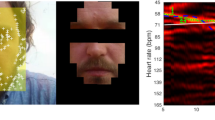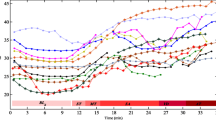Abstract
We present an optical non-contact method for heart beat monitoring, based on the measurement of chest wall movements induced by the pumping action of the heart, which is eligible as a surrogate of electrocardiogram (ECG) in assessing both cardiac rate and heart rate variability (HRV). The method is based on the optical recording of the movements of the chest wall by means of laser Doppler interferometry.
To this aim, the ECG signal and the velocity of vibration of the chest wall, named optical vibrocardiography (VCG), were simultaneously recorded on 10 subjects. The time series built from the sequences of consecutive R waves (on ECG) and vibrocardiographic (VV) intervals were compared in terms of heart rate (HR). To evaluate the ability of VCG signals as quantitative marker of the autonomic activity, HRV descriptors were also calculated on both ECG and VCG time series. HR and HRV indices obtained from the proposed method agreed with the rate derived from ECG recordings (mean percent difference <3.1%). Our comparison concludes that optical VCG provides a reliable assessment of HR and HRV analysis, with no statistical differences in term of gender are present. Optical VCG appears promising as non-contact method to monitor the cardiac activity under specific conditions, e.g., in magnetic resonance environment, or to reduce exposure risks to workers subjected to hazardous conditions. The technique may be used also to monitor subjects, e.g., severely burned, for which contact with the skin needs to be minimized.









Similar content being viewed by others
References
Acharya R., Kumar A., Bhat P. S., Lim C. M., Iyengar S. S., Kannathal N., Krishnan S. M. (2004) Classification of cardiac abnormalities using heart rate signals. Med. Biol. Eng. Comput. 42(3):288–293
Akselrod S., Gordon D., Ubel F. A., Shannon D. C., Berger A. C., Cohen R. J. (1981) Power spectrum analysis of heart rate fluctuation: A quantitative probe of beat to beat cardiovascular control. Science 213:220–222
American College of Cardiology Cardiovascular Technology Assessment Committee (1993) Heart rate variability for risk stratification of life-threatening arrhythmias. J. Am. Coll. Cardiol. 22: 948–950
Augousti, A. T., F. X. Maletras, and J. Mason. Evaluation of cardiac monitoring using fiber optic plethysmography. Ann. Biomed. Eng. [DOI: 10.1007/s10439-006-9084-x] 2006
Bland, J. M. and D. G. Altman. Statistical methods for assessing agreement between two methods of clinical measurement. Lancet 8:307–310, 1986
Castellini P., Scalise L., Tomasini E. P. (1999) Teeth mobility measurement: a laser vibrometry approach. Rev. Sci. Instrum. 70(6):2850–2855
Constant I., Laude D., Murat I., Elghozi J. L. (1999) Pulse rate variability is not a surrogate for heart rate variability. Clin. Sci. 97: 391–397
DeBoer R. W., Karemaker J. M., Strackee J. (1984) Comparing spectra of a series of point events particularly for heart rate variability data. IEEE Trans. Biomed. Eng. 31(4):384–387
De Chazal P., O’Dwyer M., Reilly R. B. (2004) Automatic classification of heartbeats using ECG morphology and heartbeat interval features. IEEE Trans. Biomed. Eng. 51(7):1196–1206
Goldberger A. L. (1991) Is the normal heartbeat chaotic or homeostatic? News Physiol. Sci. 6:87–91
Harland C. J., Clark T. D., Prance R. J. (2002) Electric potential probes – new directions in the remote sensing of the human body. Meas. Sci. Technol. 13(2):163–169
Inouye T., Shinosaki K., Sakamoto H., Toi S., Ukai S., Iyama A., Katsuda Y., Hirano M. (1991) Quantification of EEG irregularity by use of the entropy of the power spectrum. Electroencephalogr. Clin. Neurophysiol. 79(3):204–210
Kamen P. W., Krum H., Tonkin A. M. (1996) Poincare plot of heart rate variability allows quantitative display of parasympathetic nervous activity. Clin. Sci. 91:201–208
Kanal E., Shellock F. G. (1990) Burns associated with clinical MR examinations. Radiology 175 585
Kanal E., Shellock F. G. (1992) Patient monitoring during clinical MR imaging. Radiology 185(3):623–629
Kaplan D. T. (1994) The analysis of variability. J. Cardiovasc. Electrophysiol. 5:16–19
Kettenbach J., Kacher D. F., Koskinen S. K., Silverman S. G., Nabavi A., Gering D., Tempany C. M., Schwartz R. B., Kikinis R., Black P. M., Jolesz F. A. (2000) Interventional and intraoperative magnetic resonance imaging. Annu. Rev. Biomed. Eng. 2:661–690
Kugel H., Bremer C., Puschel M., Fischbach R., Lenzen H., Tombach B., Van Aken H., Heindel W. (2003) Hazardous situation in the MR bore: induction in ECG leads causes fire. Eur. Radiol. 13(4):690–694
Kuo C. D., Chen G. Y., Wang Y. Y., Hung M. J., Yang J. L. (2003) Characterization and quantification of the return map of RR intervals by Pearson coefficient in patients with acute myocardial infarction. Auton. Neurosci. 105(2):145–152
Lee S. W., Fischer P. F., Loth F., Royston T. J., Grogand J. K., Bassiounyd H. S. (2005) Flow-induced vein-wall vibration in an arteriovenous graft. J. Fluids Struct. 20:837–852
Malik, M., A. J. Camm (eds) (2004) Dynamic Electrocardiography. New York: Blackwell Futura
Malliani A., Pagani M., Lombardi F., Cerutti S. (1991) Cardiovascular neural regulation explored in the frequency domain. Circulation 84:1482–1492
Matsui T., Arai I., Gotoh S., Hattori H., Takase B., Kikuchi M., Ishihara M. (2005) A novel apparatus for non-contact measurement of heart rate variability: a system to prevent secondary exposure of medical personnel to toxic materials under biochemical hazard conditions, in monitoring sepsis or in predicting multiple organ dysfunction syndrome. Biomed. Pharmacother. 59 (Suppl 1):S188–S191
Matsui T., Hagisawa K., Ishizuka T., Takase B., Ishihara M., Kikuchi M. (2004) A novel method to prevent secondary exposure of medical and rescue personnel to toxic materials under biochemical hazard conditions using microwave radar and infrared thermography. IEEE Trans. Biomed. Eng. 51(12):2184–2188
Migliaro E. R., Canetti R., Contreras P., Hakas M., Eirea G., Machado A. (2004) Short-term studies of heart rate variability: comparison of two methods for recording. Physiol. Meas. 25(6):N15–N20
Pagani M., Lombardi F., Guzzetti S., Rimoldi O., Furlan R., Pizzinelli P., Sandrone G., Malfatto G., Dell’Orto S., Piccaluga E., et al. (1986) Power spectral analysis of heart rate and arterial pressure variabilities as a marker of sympatho-vagal interaction in man and conscious dog. Circ. Res. 59(2):178–193
Pan J., Tompkins W. J. (1985) Real Time QRS Detector algorithm. IEEE Trans. Biomed. Eng. 32(3):230–236
Pordy L., Chesky K., Master A. M., Taymor R.C, Moser M. (1952) The dual displacement and velocity ballistocardiograph apparatus. Am. Heart J. 44(2):248–256
Rezek I. A., Roberts S. J. (1998) Stochastic complexity measures for physiological signal analysis. IEEE Trans. Biomed. Eng. 45(9): 1186–1191
Rosowski J. J., Mehta R. P., Merchant S. N. (2003) Diagnostic utility of laser-Doppler vibrometry in conductive hearing loss with normal tympanic membrane. Otol. Neurotol. 24(2):165–175
Russell T. (2001) The management of burns. In: Ferrera P., Colucciello S., Marx J., Verdile V., Gibbs M. (eds) Trauma Management: An Emergency Medicine Approach. St. Louis (MO), Mosby, pp 549–565
Salerno D. M., Zanetti J., Green L., Mooney M., Madison J., Van Tassel R. (1991) Seismocardiographic changes associated with obstruction of coronary blood flow during balloon angioplasty. Am. J. Cardiol. 15;68(2):201–220
Salerno D. M., Zanetti J. (1990) Seismocardiography: A new technique for recording cardiac vibrations. Concept, method and initial observations.J. Cardiovasc. Tech. 9,2: 111–118
Scalise, L., P. Castellini, U. Morbiducci, C. Del Gaudio, G. D’Avenio, M. Grigioni, and E. P. Tomasini. Laser vibrometry to study prosthetic mechanical heart valves. Proceedings on XII Mediterranean Conference on Medical and Biological Engineering and Computing (available in CD rom) (2004)
Scalise, L., U. Morbiducci, and M. De Melis. A laser Doppler approach to cardiac motion monitoring: effects of surface and measurement position. Proceedings of SPIE VII International Conference on Vibration Measurements by Laser Techniques, 2006, 19–22 June, Ancona, Italy, 6345: 0D1-0D11
Schwartz P. J., Priori S. G. (1990) Sympathetic nervous system and cardiac arrhythmias. In: Zipes D. P, Jalife J. (eds) Cardiac Electrophysiology. From Cell to Bedside. Philadelphia, W.B. Saunders, pp 330–343
Task Force of the European Society of Cardiology and the North American Society of Pacing and Electrophysiology (1996) Heart rate variability: standards of measurement, physiological interpretation, and clinical use. Eur. Heart J. 17:354–381
Taymor R. C., Pordy L., Chesky K., Moser M., Master A. M. (1952) The ballistocardiogram in coronary artery disease. J. Am. Med. Assoc. 9; 148(6):419–423
Tomasini E. P., Revel G. M., Castellini P. (2001) Laser Based Measurement, Encyclopaedia of Vibration Academic Press, London, 699–710
Tulppo M. P., Makikallio T. H., Takala T. E. S., Seppanen T., Huikuri H. V. (1996) Quantitative beat-to-beat analysis of heart rate dynamics during exercise. Am. J. Physiol. 271:H244–H252
Woo M. A., Stevenson W. G., Moser D. K., Trelease R. B., Harper R. H. (1992) Patterns of beat-to-beat heart rate variability in advanced heart failure. Am. Heart J. 123:704–707
Acknowledgments
The authors wish to thank Professor Enrico Primo Tomasini and Dr. Giorgio Corbucci for the useful comments and the endless support to the research activity.
Author information
Authors and Affiliations
Corresponding author
Rights and permissions
About this article
Cite this article
Morbiducci, U., Scalise, L., De Melis, M. et al. Optical Vibrocardiography: A Novel Tool for the Optical Monitoring of Cardiac Activity. Ann Biomed Eng 35, 45–58 (2007). https://doi.org/10.1007/s10439-006-9202-9
Received:
Accepted:
Published:
Issue Date:
DOI: https://doi.org/10.1007/s10439-006-9202-9




